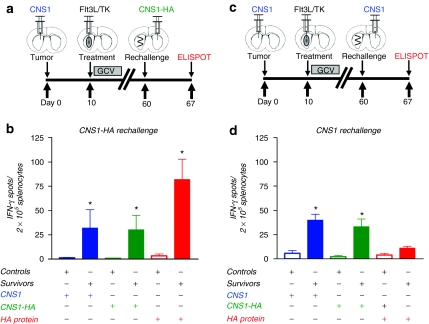Figure 6.
Ad-Flt3L and Ad-TK treated long-term survivors rechallenged with CNS1-HA tumor cells exhibit an expansion of IFN-γ secreting T lymphocyte precursors specific for hemagglutinin (HA). CNS1 cells were implanted into the striatum of Lewis rats. Ten days later, animals received an intratumoral injection of Ad-Flt3L + Ad-TK, or saline. Ganciclovir (GCV) was administered via intraperitoneal injection for seven days and animals were assessed for survival. Sixty days later, animals surviving long-term were rechallenged with either (a) CNS1-HA cells or (c) CNS1 wild type cells in the contralateral hemisphere. No further treatment was administered. Naive rats were injected with tumor cells as controls. Animals were euthanized 7 days after rechallenge and splenocytes were used for an IFN-γ ELISPOT. (b) Splenocytes from animals rechallenged with CNS1-HA or (d) CNS1-wild type tumors (n = 4/cohort) were isolated to quantitate the frequency of IFN-γ-secreting T lymphocyte precursors specific for CNS1 or CNS1-HA brain tumor cells, or HA protein by IFN-γ ELISPOT. Splenocytes from each experimental group were stimulated with either CNS1 cell lysates, CNS1-HA cell lysates, or HA pure protein. *P < 0.05 versus saline from same stimuli group, Student's t-test. IFN, interferon; Flt3L, fms-like tyrosine kinase 3 ligand; TK, thymidine kinase.

